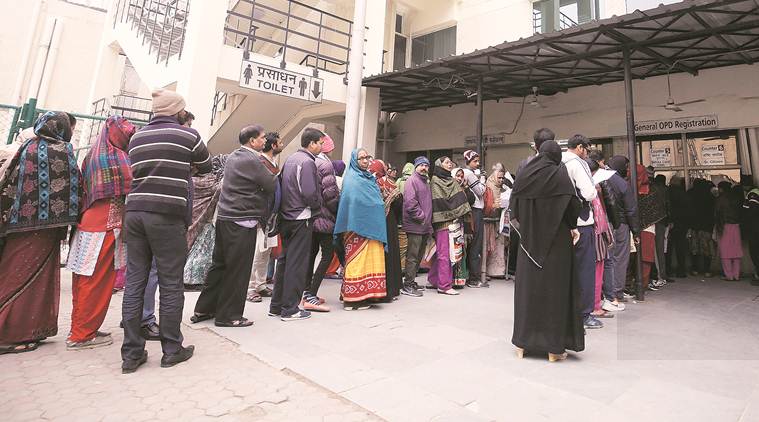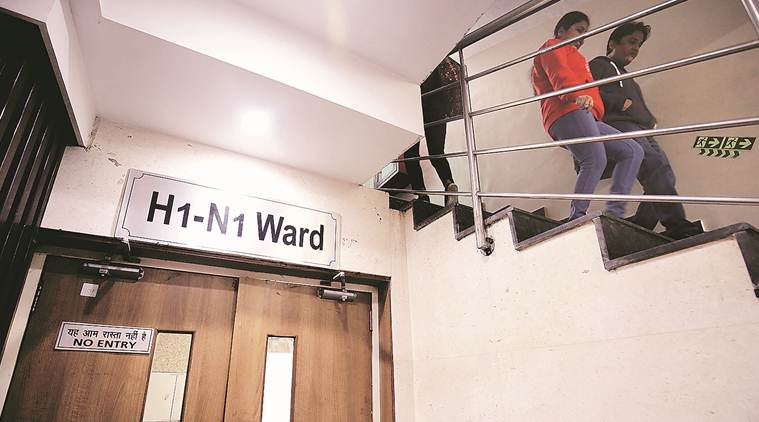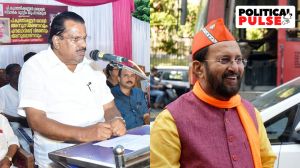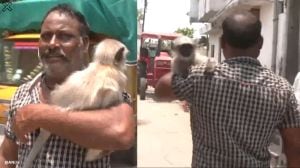- India
- International
Hardlook: Crisis H1N1, outbreak of Swine Flu
A sharp spike in swine flu cases has caught Delhi’s hospitals by surprise, with isolation wards running full and doctors advising abundant caution. Astha Saxena looks at how the healthcare setup is dealing with the crisis.
 At Sir Ganga Ram Hospital, Saturday. In January, the hospital recorded 107 swine flu cases in its OPD, and 95 in its IPD. Six deaths were also reported; (below) patients are admitted to dedicated isolation wards. (Express photo by Praveen Khanna)
At Sir Ganga Ram Hospital, Saturday. In January, the hospital recorded 107 swine flu cases in its OPD, and 95 in its IPD. Six deaths were also reported; (below) patients are admitted to dedicated isolation wards. (Express photo by Praveen Khanna)
In 2018, 205 swine flu cases were reported in Delhi, along with two confirmed deaths. January 2018 saw just 11 cases — a fraction of the 643 in the first 31 days of this year. Of the 13 deaths reported last month, nine were residents of the capital.
Health experts The Indian Express spoke to suggested that this year’s outbreak wasn’t along expected lines. According to them, the influenza is known to rear its head every third year. With relatively few cases reported last year, this year was expected to show a similar trend.
Except, it did not.
“We were not expecting that cases will reach this number. Generally, any influenza changes its trend every two years. But now, any patient coming to us with even the slightest case of cough and cold is being asked to undergo the test for swine flu,” said Dr S P Byotra, senior consultant, internal medicine, Sir Ganga Ram Hospital. In January, the hospital recorded 107 swine flu cases in its out-patient department (OPD) and 95 in its in-patient department (IPD). Six deaths were reported from the hospital.
A harsher, longer winter this time around could be one explanation for the surge in the number of cases. Data provided by the India Meteorological Department showed that January mornings this year were the coldest since 2013. The average minimum temperature, recorded early in the morning, in January was 6.6 degrees Celsius. It was 7 degrees Celsius in January 2018, and 8.7 degrees Celsius in January 2017.
According to doctors, cases generally spike during extreme weather conditions — a dip in mercury during winters and extreme humidity during the rainy season often leads to a rise in numbers. “We are surprised to see the sudden surge in cases in the last two weeks. Awareness among patients could be a reason for the higher number. But till we find out a definite reason, all this is guess work,” said Dr
S Chatterjee, senior consultant, department of internal medicine, Indraprastha Apollo Hospital.

 According to doctors, like seasonal flu, swine flu can lead to more serious complications, including pneumonia and respiratory failure. It can also make conditions such as diabetes or asthma worse. (Express Photo)
According to doctors, like seasonal flu, swine flu can lead to more serious complications, including pneumonia and respiratory failure. It can also make conditions such as diabetes or asthma worse. (Express Photo)
Hard to tell apart
Initially recorded in Mexico in 2009, swine flu was declared a pandemic by the World Health Organisation in 2010. The most common strain, H1N1, first reported in 2009, has since turned into a seasonal flu, said doctors. Symptoms include fever, cough, nasal secretion, fatigue, headache, body ache and sore throat. There are three categories of the virus — A,B and C. While the first two are considered stable, category C is dangerous and requires immediate ventilator support. “Every year, we have been seeing similar cases, due to which the virus has become seasonal. This virus is called an endemic. If the influenza takes on another form of virus, it becomes an epidemic. At present, it is transmitting from one human to another,” said Dr Jugal Kishore from the department of community medicine, Safdarjung Hospital. The hospital has seen 22 confirmed cases of H1N1 influenza, and three deaths this year.
Standard treatment for H1N1 is the Oseltamivir drug, which is to be taken only on prescription. Frequent washing of hands and avoiding crowded places are among precautions suggested by doctors to avoid catching swine flu which, because of its symptoms, is easily mistaken for the relatively harmless cough and cold.
Sitting in the H1N1 ward of Sir Ganga Ram Hospital, Bhavna Kharbanda, whose father-in-law is being treated for the disease, testifies to this: “He kept shivering for three days. There was no fever or any other symptom of swine flu. We thought it might be a case of pneumonia, but then we got the test results. The symptoms are such that it is difficult to tell whether it is swine flu.”
Caught off guard
The sudden surge in cases has also thrown the spotlight on the under-preparedness of authorities. As the number of cases spiked, the Union Ministry of Health and Family Welfare recently circulated guidelines on case diagnosis, management, vaccination, isolation criteria, risk categorisation and preventive measures to all hospitals and health facilities. Health advisories, in English and Hindi, on seasonal swine flu were also issued for the general public.
But many hospitals and patients are still complaining of a shortage of the swine flu vaccine in the market. More alarmingly, a majority of doctors and health workers in government hospitals are yet to be vaccinated against the disease. Usually, the vaccination process for health workers begins in October, but that hasn’t happened this time around.
“We all are trying to get the vaccine at our level. Those who are in close contact with patients are advised to get it done themselves. The government usually starts the process by early October, so that the vaccination can have the intended effect,” said Dr Sunil Kumar, medical director of Guru Tegh Bahadur (GTB) Hospital.
As per guidelines of the Union Ministry of Health, it takes about two-three weeks for development of immunity after the vaccine is administered. For healthcare workers in an environment that exposes them to the virus, a vaccine should be administered at least a month prior to commencement of the flu season.
 Families of those who succumbed to swine flu are still finding it hard to reconcile with how a disease they knew little about claimed the lives of their loved ones. (Express Photo)
Families of those who succumbed to swine flu are still finding it hard to reconcile with how a disease they knew little about claimed the lives of their loved ones. (Express Photo)
Not just vaccines, shortage of N95 masks and gloves is also being felt in the markets. At hospitals, to ensure that the infection doesn’t spread to other patients, those diagnosed with swine flu are admitted to isolation wards. Every hospital has set aside 5-10 beds from the existing number for such patients. The facility is generally created away from the emergency and general wards.
At Lok Nayak, one of the biggest Delhi government hospitals, doctors working closely with swine flu patients have not been vaccinated. “This was not included in the health programme of the Government of India,” said Dr Kishore Singh, medical director of the hospital. Dr Karan Madaan, associate professor, department of pulmonology, AIIMS, said that this year, “hospitals are using a quadrivalent vaccine for primary target groups, including healthcare personnel, patients with co-existing chronic diseases and immuno-compromised patients. This vaccine contains two strains each of influenza A and B. Till last year, we were administering the trivalent form of the vaccine”.
As compared to the trivalent vaccine, which has two strains of influenza A and one of B, the quadrivalent one is considered superior. It is also more expensive. While the trivalent vaccine costs around Rs 1,000-Rs 1,200, the quadrivalent one is around Rs 1,500.
“Vaccination is one of the important parts of the programme. But in the past years, we have noticed that not all health workers are readily opting for preventive measures. There have been attitudinal issues in many cases,” said Dr Jugal Kishore.
A sudden tragedy
Families of those who succumbed to swine flu are still finding it hard to reconcile with how a disease they knew little about claimed the lives of their loved ones.
For 25-year-old Ravi Kumar’s family, it started with a fever. Kumar was admitted to RML Hospital on January 7, and died on January 15. For the last six months, he had been suffering from frequent bouts of high fever, sore throat and indigestion.
But his condition deteriorated in January, and the fever touched 105 degrees. “We immediately took him to a nearby hospital, where he was admitted for 15 days. We couldn’t see any improvement in his condition, so we went to RML,” said Hari Singh, his father. According to the hospital administration, Kumar suffered multiple health issues apart from swine flu, including tuberculosis. “He had been availing treatment for the last six months, but doctors never mentioned anything about these diseases… We are still not able to understand what happened,” his father said.
According to doctors, like seasonal flu, swine flu can lead to more serious complications, including pneumonia and respiratory failure. It can also make conditions such as diabetes or asthma worse.
Pregnant women, infants, elderly and people on long-term medication or those suffering from immuno-deficiency are at high risk, and should opt for the influenza vaccine. In the case of 72-year-old Dilwar Singh, who died on January 24, the first signs were viral fever and chest congestion. But when the fever continued for a week, his family sensed something was wrong.
“After a few days, he coughed up blood and had trouble breathing. We thought it was due to chest congestion and had no idea it could be swine flu. There were not many cases in Delhi last year. By the time we took him to the hospital, his lungs, kidney and heart had been affected. We couldn’t do anything,” said Manjeet Singh, his son.
The entire family was asked to take Oseltamivir for five days as a precautionary measure. In the midst of the crisis, the Delhi government’s health department, in a meeting last week, requested all hospitals to locally purchase medicines and vaccines for staff and health workers. A dedicated helpline number has been activated so people can seek assistance on the disease.
“We call it seasonal influenza, as per WHO guidelines, and only those who develop symptoms under category C are considered to be confirmed swine flu cases. Patients with co-morbid conditions like low immunity, those on immunosuppressants, or people suffering from blood cancer, renal transplant, diabetes or heart disease are at high risk of getting infected. Till last year, we had 25 hospitals with dedicated isolation wards for swine flu patients. This year, the number has increased,” said Dr Nutan Mundeja, Director General of Health Services, Delhi government.
The Guidelines
Healthcare workers in hospitals such as doctors, nurses and paramedics with a likelihood of exposure to influenza virus should be vaccinated. This includes:
All medical, paramedical personnel working in casualty/emergency department of identified hospitals treating influenza cases
All medical and paramedical personnel working in ICU and isolation wards managing influenza patients
All personnel identified to work in screening centres set up for categorisation of patients during seasonal influenza outbreak
Laboratory personnel testing suspected influenza samples
Apr 26: Latest News
- 01
- 02
- 03
- 04
- 05








































